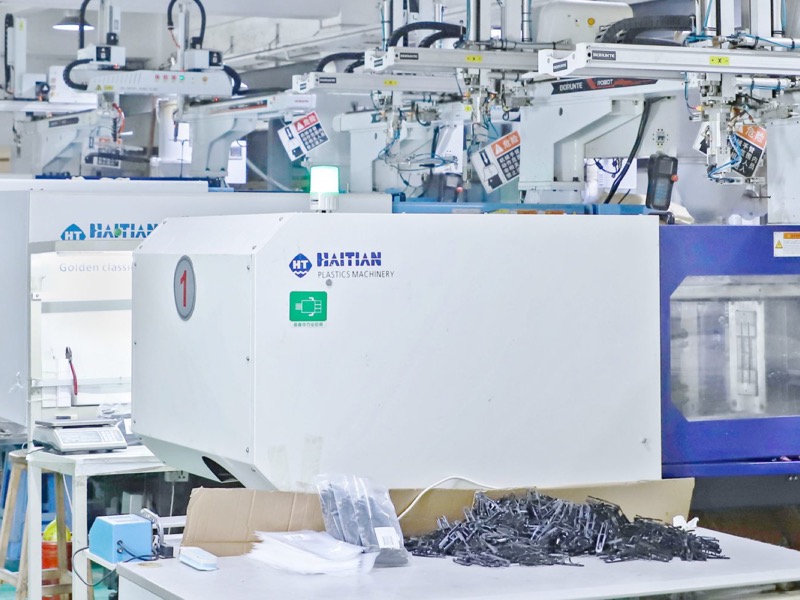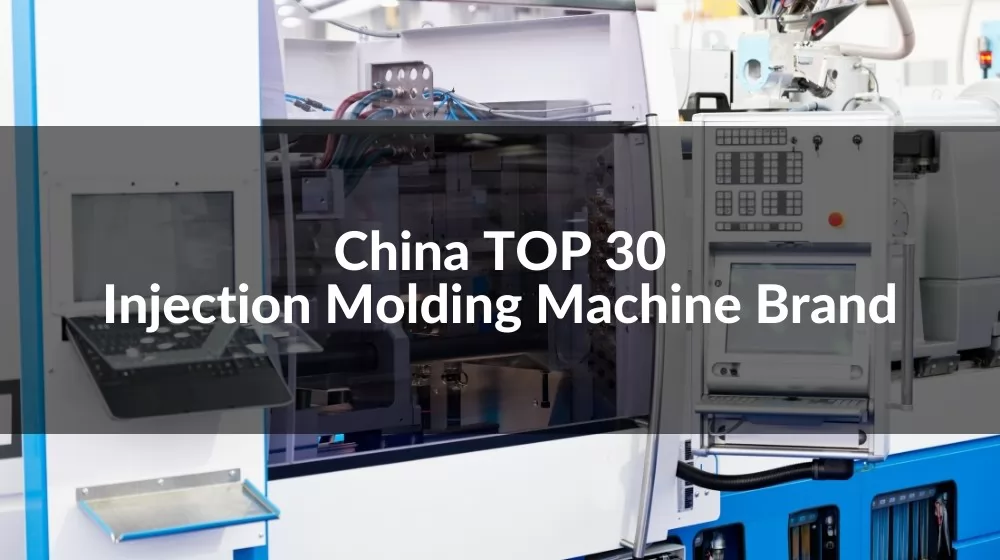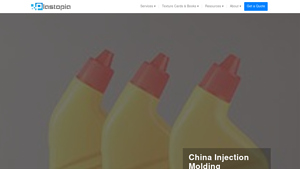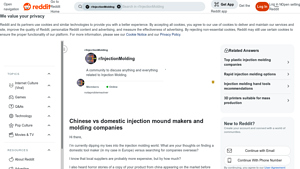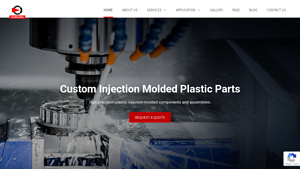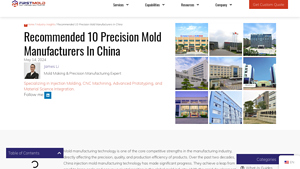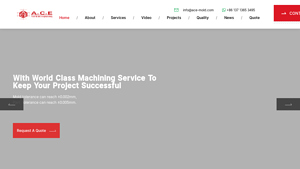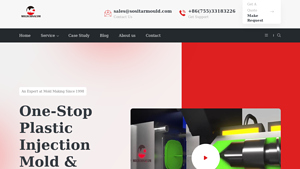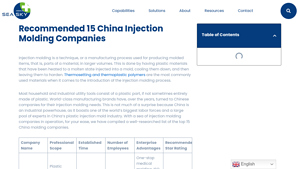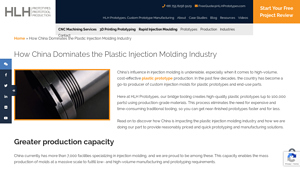Injection Molding In China Guide: Type, Cost, Top List…
Introduction: Navigating the Global Market for injection molding in china
The global landscape of injection molding in China presents a unique opportunity for international B2B buyers seeking cost-effective and high-quality manufacturing solutions. However, navigating this complex market can be daunting, particularly for companies in Africa, South America, the Middle East, and Europe, such as Brazil and Germany, that may face challenges in supplier selection, quality assurance, and understanding local manufacturing practices. This guide is designed to equip decision-makers with the essential knowledge needed to successfully source injection molded products, addressing key concerns such as material selection, production costs, and the vetting process for reliable suppliers.
Within these pages, you will discover a comprehensive overview of the injection molding process, including various types of molds, applications across multiple industries, and insights into cost-effective production strategies. We will delve into best practices for evaluating potential suppliers, emphasizing the importance of quality control and communication. By empowering you with actionable insights and expert recommendations, this guide aims to facilitate informed purchasing decisions that align with your business objectives.
Whether you are a startup looking for low-volume runs or an established enterprise seeking scalable production, understanding the intricacies of injection molding in China can unlock significant competitive advantages, allowing you to optimize your supply chain and enhance product offerings in your target markets.
Understanding injection molding in china Types and Variations
| Type Name | Key Distinguishing Features | Primary B2B Applications | Brief Pros & Cons for Buyers |
|---|---|---|---|
| Standard Injection Molding | Uses thermoplastic materials, high production efficiency | Consumer goods, automotive parts | Pros: Cost-effective for large volumes; Cons: Initial mold costs can be high. |
| Insert Molding | Combines plastic injection with metal or other materials | Electronics, automotive components | Pros: Enhances strength and functionality; Cons: Complex design increases costs. |
| Blow Molding | Produces hollow plastic parts through air inflation | Bottles, containers, automotive parts | Pros: Ideal for large hollow items; Cons: Limited to specific shapes and sizes. |
| Two-Shot Injection Molding | Utilizes two different materials in one cycle | Multicolored parts, complex assemblies | Pros: Reduces assembly time; Cons: More expensive due to complexity. |
| Micro Injection Molding | Focuses on very small parts with high precision | Medical devices, intricate components | Pros: High accuracy and detail; Cons: Specialized equipment required, increasing costs. |
What are the Characteristics of Standard Injection Molding in China?
Standard injection molding is the most commonly used method in China, characterized by its ability to process a wide range of thermoplastic materials. This process is highly efficient for mass production, making it suitable for items like consumer goods and automotive parts. B2B buyers should consider the initial costs of mold creation, which can be substantial, but the cost-per-unit decreases significantly with larger production runs.
How Does Insert Molding Enhance Product Strength?
Insert molding integrates additional materials, such as metals or other plastics, into the injection process, creating a single, robust component. This method is particularly advantageous for applications requiring enhanced durability, such as in electronics and automotive components. Buyers must weigh the added complexity and potential costs against the benefits of improved product performance and reduced assembly needs.
What are the Advantages of Blow Molding for Large Items?
Blow molding is specifically designed for creating hollow plastic products, utilizing air to inflate the heated plastic into a mold. This method is ideal for producing items like bottles and containers. While it offers significant cost savings for large-scale production, buyers should note that it is limited in terms of design flexibility, as it can only produce specific shapes.
Why Choose Two-Shot Injection Molding for Complex Assemblies?
Two-shot injection molding allows manufacturers to use two different materials in a single molding cycle, producing parts with multiple colors or properties. This technique is beneficial for creating complex assemblies that require varied functionality in a single part. However, the complexity of this process can lead to higher costs, which buyers should consider in their budget planning.
What Makes Micro Injection Molding Suitable for Medical Applications?
Micro injection molding is tailored for producing extremely small and precise components, making it highly suitable for industries like medical devices. This method requires specialized equipment to achieve the necessary detail and accuracy. B2B buyers should evaluate the potential for higher costs due to the specialized nature of this process against the critical need for precision in their applications.
Key Industrial Applications of injection molding in china
| Industry/Sector | Specific Application of Injection Molding in China | Value/Benefit for the Business | Key Sourcing Considerations for this Application |
|---|---|---|---|
| Automotive | Production of automotive interior components | High precision and lightweight parts enhance vehicle performance | Ensure compliance with international safety and quality standards |
| Electronics | Manufacturing of casings and components for devices | Cost-effective production of complex shapes and designs | Focus on supplier certifications and experience in electronics |
| Consumer Goods | Creation of packaging solutions | Customizable designs that improve brand visibility and product protection | Assess material options for sustainability and regulatory compliance |
| Medical Devices | Fabrication of surgical instruments and devices | High-quality and sterile components ensure patient safety | Verify quality control processes and certifications (ISO, FDA) |
| Home Appliances | Production of appliance housings and parts | Durable and aesthetically pleasing products increase market competitiveness | Evaluate logistics for timely delivery and cost-effectiveness |
How is Injection Molding Used in the Automotive Industry in China?
In the automotive sector, injection molding is essential for producing interior components such as dashboards, panels, and trims. The process allows manufacturers to create lightweight and high-precision parts that meet stringent performance standards. For international buyers, particularly from regions like Europe and South America, it is crucial to partner with suppliers who adhere to international safety regulations and quality certifications to mitigate risks associated with product recalls and compliance failures.
What Role Does Injection Molding Play in Electronics Manufacturing in China?
Injection molding is pivotal in the electronics industry for creating casings, connectors, and intricate components that require precise tolerances. This method enables the production of complex shapes that can optimize space and functionality within electronic devices. Buyers from Africa and the Middle East should prioritize suppliers with proven expertise in electronics and robust quality control systems, ensuring that products meet global standards and are delivered on time.
How is Injection Molding Transforming Consumer Goods Packaging in China?
In the consumer goods sector, injection molding is utilized to create innovative and customizable packaging solutions. This approach not only enhances product protection but also allows brands to differentiate themselves in competitive markets. For international B2B buyers, especially in South America, it is important to consider the sustainability of materials used in packaging, as well as compliance with local regulations regarding recyclability and safety.
Why is Injection Molding Critical for Medical Device Manufacturing in China?
Injection molding is vital for producing high-quality surgical instruments and medical devices that require stringent sterilization and precision. The ability to create complex geometries with consistent quality is essential for ensuring patient safety. Buyers from Europe and the Middle East must ensure that their suppliers have robust quality control measures and certifications such as ISO and FDA compliance, which are critical in the medical field.
How Does Injection Molding Benefit Home Appliance Production in China?
In the home appliance sector, injection molding is used to manufacture durable and aesthetically pleasing housings and components. This method facilitates the efficient production of parts that not only meet functional requirements but also enhance the overall product design. B2B buyers, particularly from Africa and South America, should assess the logistical capabilities of suppliers to ensure timely delivery and cost-effectiveness, which are vital for maintaining competitive pricing in the market.
3 Common User Pain Points for ‘injection molding in china’ & Their Solutions
Scenario 1: Navigating Communication Barriers in Sourcing Injection Molding Services
The Problem:
International B2B buyers often face significant communication challenges when sourcing injection molding services from China. Language barriers, cultural differences, and varying business practices can lead to misunderstandings regarding project specifications, timelines, and quality expectations. This can result in delays, unexpected costs, and ultimately a product that does not meet the buyer’s needs, causing frustration and potential financial loss.
The Solution:
To overcome these communication barriers, it’s essential to partner with a supplier that employs bilingual staff who are not only fluent in English but also possess a solid understanding of engineering and manufacturing concepts. When initiating contact, provide clear, detailed specifications for your project, including drawings, material requirements, and quality standards. Establish regular communication channels—such as scheduled video calls and project management tools—that allow for real-time updates and feedback. Additionally, consider hiring a local intermediary or consultant who understands both cultures and can facilitate communication. This approach will ensure that both parties are aligned on expectations and can significantly reduce the risk of miscommunication.
Scenario 2: Concerns About Quality Control in Injection Molding
The Problem:
Quality control is a paramount concern for B2B buyers engaging in injection molding in China. Many buyers worry about the consistency of product quality, especially when dealing with low-cost manufacturers. Issues such as dimensional inaccuracies, surface finish defects, and material inconsistencies can lead to costly rework or product recalls, damaging the buyer’s reputation and bottom line.
The Solution:
To mitigate quality concerns, buyers should prioritize working with manufacturers who have established quality management systems, such as ISO certifications. Request detailed documentation of their quality control processes, including inspection protocols and testing methods. Additionally, consider implementing a pre-production sample approval process, where the manufacturer produces a prototype for your review before full-scale production begins. This allows for adjustments and ensures that the final product meets your specifications. Regular on-site visits or third-party inspections during production can also help maintain quality standards, providing peace of mind that the product will meet your expectations upon delivery.
Scenario 3: Managing Costs in the Injection Molding Process
The Problem:
Cost management is a critical issue for B2B buyers when sourcing injection molding services from China. Buyers often encounter unexpected costs due to fluctuating raw material prices, hidden fees, or underestimations of production runs. This can create budget overruns and disrupt financial planning, particularly for small to medium-sized enterprises that may have tighter margins.
The Solution:
To effectively manage costs, it’s important to have a transparent pricing agreement with your chosen manufacturer. Request a detailed breakdown of all costs involved, including tooling, production, and any additional services like assembly or finishing. Utilize the benefits of low-volume runs when necessary; many Chinese manufacturers are willing to accommodate small orders, which can help reduce initial investment risks. Moreover, consider sourcing materials through the manufacturer to avoid price surges from external suppliers. Establishing a long-term partnership with a reliable manufacturer can also lead to better pricing agreements over time, as they will be more inclined to offer favorable rates to repeat clients. Regularly review your production requirements and adjust orders to align with market trends and material costs, ensuring that you remain within budget without sacrificing quality.
Strategic Material Selection Guide for injection molding in china
What Are the Key Materials for Injection Molding in China?
When considering injection molding in China, selecting the right material is critical for ensuring product performance and cost-effectiveness. Below, we analyze four common materials used in injection molding, focusing on their properties, advantages, disadvantages, and considerations for international B2B buyers.
How Does Polypropylene (PP) Perform in Injection Molding?
Polypropylene (PP) is a widely used thermoplastic known for its versatility. It has a temperature rating of approximately 100°C and exhibits good chemical resistance, making it suitable for various applications, including automotive parts and consumer goods.
Pros: Polypropylene is lightweight, cost-effective, and offers good fatigue resistance. Its low density contributes to lower shipping costs, which is advantageous for international buyers.
Cons: However, PP has lower impact strength compared to other materials, which may limit its use in high-stress applications. Additionally, it may require specific additives to enhance its UV stability.
Impact on Application: PP is compatible with a wide range of media, but its performance may degrade under prolonged exposure to high temperatures or aggressive chemicals.
Considerations for International Buyers: Compliance with standards such as ASTM and REACH is essential. Buyers from regions like Europe and South America should ensure that the material meets local regulations regarding safety and environmental impact.
What Are the Advantages of Acrylonitrile Butadiene Styrene (ABS)?
Acrylonitrile Butadiene Styrene (ABS) is another popular choice, known for its excellent impact resistance and toughness. It can withstand temperatures up to 80°C and is often used in consumer electronics and automotive applications.
Pros: ABS is easy to machine and can be painted or glued, which enhances its aesthetic appeal. Its durability makes it suitable for products that require a robust finish.
Cons: The primary drawback is its susceptibility to chemical damage from solvents and certain oils. Additionally, ABS can be more expensive than PP, impacting overall production costs.
Impact on Application: ABS is ideal for applications requiring a smooth surface finish, but care must be taken regarding chemical exposure.
Considerations for International Buyers: Buyers should verify compliance with international standards like ISO and ASTM, especially for electronics and automotive applications where safety is paramount.
How Does Polycarbonate (PC) Compare in Terms of Performance?
Polycarbonate (PC) is known for its high impact resistance and optical clarity, making it a preferred material for applications such as safety goggles and light covers. It can handle temperatures up to 120°C.
Pros: PC is exceptionally strong and can be used in applications requiring transparency and durability. Its ability to withstand high temperatures adds to its versatility.
Cons: However, PC is more expensive than both PP and ABS, which can affect budget constraints. It is also prone to scratching unless treated with a hard coating.
Impact on Application: PC is suitable for applications requiring high strength and transparency, but its susceptibility to scratching may limit its use in certain environments.
Considerations for International Buyers: Buyers should ensure that the PC used complies with relevant safety standards, particularly in regions with stringent regulations, such as the EU.
What Role Does Nylon (PA) Play in Injection Molding?
Nylon (Polyamide, PA) is recognized for its excellent mechanical properties and resistance to wear and abrasion. It can withstand temperatures of up to 180°C, making it suitable for demanding applications like automotive and industrial components.
Pros: Nylon is durable, has high tensile strength, and is resistant to many chemicals, making it suitable for a variety of environments. Its self-lubricating properties can reduce wear in moving parts.
Cons: The primary disadvantage is its moisture absorption, which can affect dimensional stability. Additionally, nylon can be more challenging to process compared to other materials.
Impact on Application: Nylon’s compatibility with various media makes it suitable for applications in harsh environments, but moisture control is crucial.
Considerations for International Buyers: Compliance with industry-specific standards is vital, especially for automotive applications. Buyers should also consider the availability of nylon grades that meet their specific performance needs.
Summary Table of Material Selection for Injection Molding in China
| Material | Typical Use Case for injection molding in china | Key Advantage | Key Disadvantage/Limitation | Relative Cost (Low/Med/High) |
|---|---|---|---|---|
| Polypropylene | Automotive parts, consumer goods | Lightweight and cost-effective | Lower impact strength | Low |
| Acrylonitrile Butadiene Styrene (ABS) | Consumer electronics, automotive components | Excellent impact resistance | Susceptible to chemical damage | Medium |
| Polycarbonate | Safety goggles, light covers | High impact resistance and optical clarity | More expensive and prone to scratching | High |
| Nylon (PA) | Automotive and industrial components | Durable and resistant to wear | Moisture absorption affects stability | Medium |
This strategic material selection guide provides international B2B buyers with essential insights into the materials available for injection molding in China, helping them make informed decisions tailored to their specific needs.
In-depth Look: Manufacturing Processes and Quality Assurance for injection molding in china
What Are the Key Manufacturing Processes for Injection Molding in China?
The injection molding process in China is characterized by several critical stages, each integral to producing high-quality plastic parts. Understanding these processes can help international B2B buyers ensure they are partnering with reliable manufacturers.
How Is Material Prepared for Injection Molding?
The first step in the injection molding process involves the preparation of raw materials, typically thermoplastics or thermosetting plastics. Suppliers often source materials that meet specific industry standards to ensure compatibility with the intended application. Material preparation includes drying the plastic pellets to remove moisture, which can lead to defects in the final product.
Once dried, the pellets are mixed and fed into a hopper connected to the injection molding machine. Here, precise temperature control is crucial, as it affects the melting point and flow characteristics of the plastic.
What Techniques Are Used in the Forming Stage?
The forming stage is where the actual shaping of the plastic occurs. The melted plastic is injected into a mold under high pressure. This stage can utilize various techniques, such as:
- Conventional Injection Molding: The most common method, effective for high-volume production.
- Gas-Assisted Injection Molding: This technique helps reduce material usage and enhances the strength of hollow parts.
- Multi-material Injection Molding: Allows for the combination of different plastics in a single part, enabling diverse functionality and aesthetic appeal.
After the injection, the mold is cooled, and the solidified part is ejected. The cycle time can vary, but efficient manufacturers in China typically optimize this for faster production rates.
How Are Parts Assembled and Finished?
After forming, parts may require additional assembly or finishing. This might include:
- Secondary Operations: Such as drilling, cutting, or welding to create more complex assemblies.
- Surface Finishing: Techniques like painting, plating, or polishing enhance the aesthetic and functional properties of the parts.
Manufacturers often provide these services in-house, which streamlines the supply chain and minimizes lead times for B2B buyers.
What Quality Assurance Measures Are Implemented in Injection Molding?
Quality assurance (QA) is a critical aspect of the injection molding process in China, ensuring that products meet both local and international standards.
Which International Standards Are Relevant for Quality Assurance?
Most reputable manufacturers in China adhere to ISO 9001, an international standard that outlines the requirements for a quality management system. This certification signifies a company’s commitment to consistent quality and customer satisfaction. Additionally, industry-specific certifications like CE (for European markets) and API (for petroleum-related applications) may also be relevant, depending on the product type.
What Are the Key Quality Control Checkpoints?
Quality control in the injection molding process typically involves several checkpoints:
- Incoming Quality Control (IQC): Raw materials are inspected upon arrival to ensure they meet specifications.
- In-Process Quality Control (IPQC): During production, samples are regularly tested for dimensional accuracy and visual defects.
- Final Quality Control (FQC): Finished products undergo a thorough inspection to verify they meet all quality standards before shipping.
These checkpoints help identify and rectify any issues early in the process, reducing waste and ensuring high-quality outcomes.
How Can B2B Buyers Verify Supplier Quality Control?
For international B2B buyers, especially from regions like Africa, South America, the Middle East, and Europe, verifying a supplier’s quality control processes is essential. Here are some actionable steps:
What Types of Audits and Reports Can Buyers Request?
Buyers should conduct supplier audits to evaluate the manufacturer’s capabilities and quality control practices. Requesting documentation such as:
- Quality Management System (QMS) Reports: These documents outline the procedures and standards the manufacturer follows.
- Inspection Reports: Regular reports detailing the results of IQC, IPQC, and FQC can provide insights into the supplier’s reliability.
Should Buyers Consider Third-Party Inspections?
Engaging third-party inspection services can offer an objective assessment of a supplier’s quality practices. These organizations can perform audits, verify compliance with international standards, and conduct product inspections before shipment, ensuring that the final products meet the required specifications.
What Are the Quality Control Nuances for International B2B Buyers?
Navigating quality control can be complex for international buyers, particularly when working with suppliers in China. Here are some nuances to consider:
How Do Cultural Differences Impact Quality Control?
Cultural perceptions of quality can differ significantly between regions. For instance, a manufacturer may prioritize cost-efficiency over stringent quality checks, which can lead to discrepancies in product quality. Therefore, establishing clear communication regarding quality expectations from the outset is crucial.
What Should Buyers Know About Language Barriers?
Language barriers can pose challenges in ensuring quality standards are met. Buyers should consider working with suppliers who have bilingual staff or employing translation services to facilitate clear communication regarding specifications and quality requirements.
Conclusion
Understanding the manufacturing processes and quality assurance measures in injection molding in China is essential for international B2B buyers. By familiarizing themselves with the stages of production, relevant quality standards, and verification methods, buyers can make informed decisions and establish successful partnerships with Chinese manufacturers. This diligence not only enhances product quality but also builds long-term relationships that can drive business growth in diverse markets.
Practical Sourcing Guide: A Step-by-Step Checklist for ‘injection molding in china’
Introduction
Navigating the landscape of injection molding in China can be complex, especially for international B2B buyers. This guide provides a practical checklist to streamline your sourcing process, ensuring you make informed decisions that lead to successful partnerships and high-quality products.
Step 1: Define Your Technical Specifications
Clearly outlining your product requirements is essential before reaching out to suppliers. Consider factors such as dimensions, tolerances, and specific material needs. This ensures that potential suppliers can provide accurate quotes and avoid miscommunication later in the process.
- Material Selection: Specify the type of plastic and any special properties required (e.g., high-temperature resistance).
- Volume Requirements: Determine the production volume needed, as this influences pricing and supplier capabilities.
Step 2: Research and Shortlist Potential Suppliers
Conduct thorough research to create a shortlist of reputable injection molding companies in China. Look for suppliers with experience in your industry and positive customer feedback.
- Supplier Directories: Utilize platforms like Alibaba or Global Sources to find verified manufacturers.
- Industry Associations: Check for membership in relevant associations, which can indicate reliability and adherence to industry standards.
Step 3: Evaluate Potential Suppliers
Before committing, it’s crucial to vet suppliers thoroughly. Request company profiles, case studies, and references from buyers in a similar industry or region. Don’t just rely on their website.
- Quality Certifications: Look for ISO certifications or other relevant quality assurance credentials.
- Factory Visits: If possible, arrange a visit to the factory to observe their operations and quality control processes.
Step 4: Request Quotes and Compare Costs
After narrowing down your options, request detailed quotes from your shortlisted suppliers. Ensure that the quotes include all costs associated with production, such as tooling, shipping, and potential tariffs.
- Cost Transparency: Seek suppliers who provide clear breakdowns of pricing, avoiding hidden fees that can inflate costs unexpectedly.
- Lead Times: Compare not only prices but also production and delivery timelines to align with your project schedule.
Step 5: Assess Communication and Support
Effective communication is vital for a successful partnership. Evaluate how responsive and helpful suppliers are during the initial interactions.
- Language Proficiency: Ensure that your primary contact has a strong command of your language to minimize misunderstandings.
- Customer Support: Inquire about their support channels, such as dedicated project managers or technical assistance for design optimization.
Step 6: Negotiate Terms and Conditions
Once you’ve selected a supplier, negotiate the terms of your agreement. This should cover payment terms, delivery schedules, and warranty conditions.
- Payment Methods: Opt for secure payment options to protect your investment.
- Contract Clauses: Ensure that the contract includes clauses for quality assurance and recourse in case of defects or delays.
Step 7: Initiate a Trial Order
Before placing a large order, start with a smaller trial run to assess the quality of the products and the reliability of the supplier. This step can help you identify any potential issues early.
- Quality Assessment: Use this trial to evaluate the final product against your specifications and quality standards.
- Feedback Loop: Provide feedback to the supplier and assess their willingness to make adjustments if necessary.
By following these steps, international B2B buyers can effectively navigate the complexities of sourcing injection molding services in China, ensuring a successful partnership that meets their production needs.
Comprehensive Cost and Pricing Analysis for injection molding in china Sourcing
What Are the Key Cost Components for Injection Molding in China?
When sourcing injection molding services in China, understanding the cost structure is crucial. The primary components contributing to the overall cost include:
-
Materials: The choice of resin significantly impacts pricing. While basic materials may cost less, specialty plastics can increase costs by up to 100%. Buyers should consider the specific application of the molded parts and opt for materials that offer the best balance between performance and cost.
-
Labor: Labor costs in China are relatively low compared to Europe and the Americas. However, skilled labor is essential for complex projects, and this can slightly elevate costs. Companies should ensure that the manufacturers employ trained personnel to maintain quality.
-
Manufacturing Overhead: This includes utilities, facility maintenance, and administrative expenses. Medium-sized manufacturers often provide more competitive pricing due to lower overhead compared to larger firms.
-
Tooling: Tooling costs can range from $1,000 to several thousand dollars, depending on the complexity and size of the mold. It’s essential to factor this into the overall project budget. Some suppliers offer free design analysis to optimize costs.
-
Quality Control (QC): Quality assurance processes, including inspections and testing, add to the overall cost. However, investing in robust QC can save money in the long run by reducing defects and rework.
-
Logistics: Shipping costs vary based on the destination and chosen Incoterms. Understanding these costs is vital, especially for international buyers.
-
Margin: Suppliers typically add a profit margin that can vary widely. Buyers should negotiate this aspect, especially when placing large orders.
What Influences Pricing for Injection Molding Projects?
Several factors can influence the pricing of injection molding services in China:
-
Volume/MOQ: The minimum order quantity (MOQ) significantly affects pricing. Higher volumes often lead to reduced per-unit costs, making it more economical for larger orders.
-
Specifications and Customization: Custom designs and specifications can increase costs. Buyers should work closely with suppliers during the design phase to minimize changes post-tooling.
-
Materials Quality and Certifications: Higher-quality materials and certifications (e.g., ISO) can lead to higher costs. However, they often ensure better performance and compliance with international standards.
-
Supplier Factors: The reputation and experience of the supplier play a crucial role in pricing. Established suppliers may charge more but offer superior quality and reliability.
-
Incoterms: The choice of Incoterms affects logistics costs and risk management. Understanding terms like FOB (Free on Board) and CIF (Cost, Insurance, and Freight) is essential for effective budgeting.
How Can Buyers Negotiate Better Pricing for Injection Molding in China?
To secure the best possible pricing, buyers should consider the following strategies:
-
Leverage Volume Discounts: When possible, consolidate orders to meet higher MOQs for better pricing. Suppliers are often willing to negotiate based on order size.
-
Request Detailed Quotes: Always ask for itemized quotes that break down costs. This transparency allows for better negotiation on specific components like tooling or materials.
-
Consider Total Cost of Ownership: Evaluate the long-term costs associated with the product, including maintenance and potential replacement costs. Sometimes, paying slightly more upfront can result in savings down the line.
-
Build Relationships with Suppliers: Establishing a strong relationship can lead to better terms and pricing flexibility. Frequent communication and clear expectations can foster trust and reliability.
-
Be Aware of Pricing Nuances: International buyers should be mindful of currency fluctuations and import duties that can impact the final cost. Understanding these factors can aid in more accurate budgeting.
Conclusion
While sourcing injection molding services in China can offer significant cost advantages, it requires careful consideration of various cost components and pricing influencers. By understanding these elements and employing strategic negotiation tactics, international buyers can optimize their sourcing decisions, ensuring high-quality products at competitive prices. Always keep in mind that prices can fluctuate, and it’s essential to engage in thorough discussions with potential suppliers to establish a clear understanding of the costs involved.
Alternatives Analysis: Comparing injection molding in china With Other Solutions
When considering manufacturing options for plastic parts, businesses often explore various methods to identify the most efficient and cost-effective solution. This analysis will compare injection molding in China with two viable alternatives: 3D printing and blow molding. Each method has its strengths and weaknesses, making it crucial for international buyers to assess their specific needs before making a decision.
| Comparison Aspect | Injection Molding in China | 3D Printing | Blow Molding |
|---|---|---|---|
| Performance | High precision and consistency for large volumes; best for complex designs. | Excellent for prototypes and low-volume production; less consistent for mass production. | Ideal for hollow objects; high-speed production but less precise than injection molding. |
| Cost | Lower cost per unit for high volumes; initial mold costs can be high. | High per-unit cost for large quantities; cost-effective for small runs. | Competitive for large quantities; lower setup costs than injection molding. |
| Ease of Implementation | Requires mold design and production; longer lead times. | Quick setup; no molds needed; designs can be easily modified. | Requires mold design; quicker than injection molding but less flexible than 3D printing. |
| Maintenance | Regular maintenance of molds required; potential for wear and tear. | Minimal maintenance; technology is straightforward and evolving. | Requires periodic maintenance of molds; less frequent than injection molding. |
| Best Use Case | High-volume production with complex geometries; industrial applications. | Prototyping, custom parts, and small batches; rapid iteration. | Production of hollow containers and parts; consumer goods. |
What Are the Pros and Cons of 3D Printing Compared to Injection Molding in China?
3D printing is a revolutionary technology that allows for rapid prototyping and the production of complex designs without the need for molds. This method is particularly advantageous for startups and small businesses looking to test product designs quickly and affordably. However, while it excels in flexibility and speed, 3D printing can become cost-prohibitive when scaling up production to high volumes, as the per-unit costs significantly increase.
How Does Blow Molding Compare to Injection Molding in China?
Blow molding is a widely used manufacturing process for producing hollow plastic parts, such as bottles and containers. It offers a competitive edge in terms of speed and lower setup costs compared to injection molding. However, it lacks the precision and versatility of injection molding, especially when dealing with complex designs. Blow molding is best suited for high-volume production runs of simpler shapes, making it less ideal for companies needing intricate parts.
How Can B2B Buyers Choose the Right Solution for Their Needs?
When selecting between injection molding in China and its alternatives, international B2B buyers should assess their specific requirements, including production volume, design complexity, and budget constraints. For high-volume runs requiring precision, injection molding in China remains a leading choice. Conversely, for rapid prototyping or low-volume needs, 3D printing may be more suitable. If the project involves hollow parts, blow molding could provide an efficient solution. By carefully evaluating these factors, businesses can make informed decisions that align with their operational goals and market demands.
Essential Technical Properties and Trade Terminology for injection molding in china
What Are the Essential Technical Properties in Injection Molding?
When engaging in injection molding, particularly in China, understanding critical technical properties is vital for ensuring product quality and operational efficiency. Here are some essential specifications that every B2B buyer should be aware of:
-
Material Grade: The type of plastic resin used in injection molding directly affects the durability, flexibility, and overall performance of the final product. Common materials include ABS (Acrylonitrile Butadiene Styrene), PC (Polycarbonate), and PP (Polypropylene). Selecting the appropriate material grade is crucial for applications in industries such as automotive, electronics, and consumer goods.
-
Tolerance: Tolerance refers to the allowable variation in dimensions during the manufacturing process. It is expressed as a range (e.g., ±0.1 mm) and is critical in ensuring parts fit together correctly. High precision in tolerance is especially important for components that require assembly or integration into larger systems, such as machinery or electronic devices.
-
Cycle Time: This is the total time taken to complete one injection molding cycle, including injection, cooling, and ejection phases. Optimizing cycle time can lead to increased production efficiency and reduced costs. Understanding cycle time is essential for planning production schedules and managing inventory levels.
-
Surface Finish: The surface finish of a molded part can significantly impact its aesthetic appeal and functionality. Common finishes include matte, glossy, and textured. A well-defined surface finish can enhance product quality and customer satisfaction, making it a crucial consideration for branding and marketing.
-
Injection Pressure: This refers to the pressure applied to inject the molten plastic into the mold. The correct injection pressure is vital for achieving a complete fill of the mold and preventing defects such as short shots or voids. Monitoring injection pressure can help ensure consistent quality in production.
-
Shrinkage Rate: All plastics shrink as they cool, and understanding the shrinkage rate is crucial for precise mold design and part dimensions. This property helps manufacturers predict how much a part will contract after cooling, ensuring that the final product meets the desired specifications.
What Are Common Trade Terms Used in Injection Molding?
Navigating the world of injection molding also involves familiarizing oneself with specific trade terminology. Here are some common terms that B2B buyers should know:
-
OEM (Original Equipment Manufacturer): This term refers to companies that manufacture products based on the specifications of another company, typically for resale. Understanding OEM relationships is vital for buyers looking to outsource production while maintaining brand integrity.
-
MOQ (Minimum Order Quantity): MOQ is the minimum number of units a supplier is willing to produce for an order. This term is significant for buyers as it affects pricing, inventory management, and production planning. Lower MOQs can be advantageous for startups or companies testing new products.
-
RFQ (Request for Quotation): An RFQ is a document sent to suppliers asking for pricing and terms for specific products or services. This process is essential for comparing costs and selecting the right manufacturer, particularly when sourcing from countries like China.
-
Incoterms (International Commercial Terms): These are standardized terms that define the responsibilities of buyers and sellers in international transactions. Familiarity with Incoterms is crucial for understanding shipping costs, risk management, and liability during the transportation of goods.
-
Lead Time: Lead time refers to the time taken from placing an order to delivery. Understanding lead times is essential for effective project management and inventory control, especially in industries with tight production schedules.
-
T1 (First Article Inspection): This term refers to the initial sample of a product produced after the mold is made. A T1 inspection ensures that the product meets the specified design and quality standards before full-scale production begins, reducing the risk of defects in later batches.
By grasping these essential technical properties and trade terms, international buyers can make informed decisions and foster successful partnerships in the injection molding industry in China.
Navigating Market Dynamics and Sourcing Trends in the injection molding in china Sector
What Are the Current Market Dynamics and Key Trends in Injection Molding in China?
The injection molding sector in China is experiencing a significant transformation, driven by global economic recovery, technological advancements, and changing consumer preferences. One of the primary global drivers is the escalating demand for high-quality, customized plastic components across various industries, including automotive, electronics, and consumer goods. As manufacturers in Africa, South America, the Middle East, and Europe (notably Brazil and Germany) seek cost-effective solutions, China’s injection molding industry stands out due to its competitive pricing and advanced capabilities.
Emerging B2B technology trends include the adoption of Industry 4.0 principles, which incorporate automation, data exchange, and smart manufacturing. These innovations enhance efficiency, reduce lead times, and improve quality control, providing international buyers with a reliable sourcing option. The increasing use of simulation software for mold design and prototyping is another trend, allowing companies to minimize errors and accelerate product development.
Furthermore, the market is witnessing a shift towards low-volume production runs, catering to startups and small to medium-sized enterprises (SMEs) that require flexibility without compromising on quality. This trend is particularly appealing to international buyers who may not need large quantities but still seek high precision and reliability in their products. As such, understanding these dynamics is crucial for B2B buyers to navigate the complexities of sourcing injection molded components from China effectively.
How Is Sustainability Shaping Sourcing Decisions in the Injection Molding Sector?
Sustainability has become a pivotal concern in the injection molding sector, influencing sourcing decisions among international B2B buyers. The environmental impact of plastic production, including waste generation and carbon emissions, has prompted companies to seek more sustainable practices. This includes a growing emphasis on ethical supply chains that prioritize transparency and social responsibility.
For B2B buyers, engaging with suppliers who offer ‘green’ certifications can be a significant differentiator. Certifications such as ISO 14001, which focuses on effective environmental management systems, and the use of recycled or bio-based materials can enhance a company’s reputation and appeal to environmentally conscious consumers. Suppliers in China are increasingly adopting these practices, aligning their operations with global sustainability goals.
Moreover, the integration of sustainable materials in injection molding processes is gaining traction. High-temperature plastics and biodegradable alternatives are now more accessible, providing buyers with options that align with their sustainability objectives. As the global market continues to evolve, prioritizing sustainability in sourcing decisions will not only mitigate environmental impact but also foster long-term business relationships based on shared values.
What Is the Evolution of the Injection Molding Industry in China?
The injection molding industry in China has evolved significantly over the past few decades, transitioning from a low-cost manufacturing hub to a leader in high-precision, technologically advanced production. Initially, the sector was characterized by low labor costs and basic manufacturing capabilities, primarily catering to domestic markets and low-end products.
As global demand for quality and innovation increased, Chinese manufacturers began investing heavily in advanced technologies and skilled labor. The introduction of modern injection molding machines and automation has enabled greater precision and efficiency, attracting international buyers looking for reliable sourcing options. Today, China stands as a pivotal player in the global injection molding market, known for its ability to deliver complex, high-quality products while maintaining competitive pricing.
This evolution is crucial for B2B buyers to understand, as it highlights the potential for partnership with Chinese manufacturers who are not only cost-effective but also capable of meeting stringent quality and sustainability standards. As the industry continues to mature, collaboration with innovative suppliers will be key to navigating the challenges and opportunities in the global marketplace.
Frequently Asked Questions (FAQs) for B2B Buyers of injection molding in china
-
How do I find a reliable injection molding supplier in China?
To identify a reliable injection molding supplier in China, start by researching potential manufacturers through online platforms, industry directories, and trade shows. Look for suppliers with positive reviews, relevant certifications (like ISO), and a strong portfolio of past projects. Request references from previous clients and assess their communication responsiveness and willingness to provide detailed information. Additionally, consider visiting the facility if possible, or use third-party inspection services to verify the supplier’s capabilities and quality control processes. -
What is the minimum order quantity (MOQ) for injection molding in China?
Minimum order quantities (MOQs) for injection molding can vary significantly depending on the supplier and the specifics of your project. Many manufacturers set MOQs ranging from 1,000 to 5,000 units for standard products. However, some companies, particularly those catering to startups or smaller businesses, may accommodate lower volumes. Discuss your requirements with potential suppliers to find a mutually agreeable MOQ that aligns with your budget and production needs. -
What are the typical payment terms for injection molding services in China?
Payment terms for injection molding projects in China usually involve a deposit followed by the balance payment upon completion. Commonly, suppliers require a 30-50% upfront payment before commencing production, with the remaining amount due after mold completion or before shipping. It’s essential to negotiate terms that protect your interests, such as using letters of credit or escrow services to ensure that funds are released only when agreed milestones are met. -
How can I ensure quality control in injection molding?
To ensure quality control during the injection molding process, collaborate closely with your supplier to establish clear quality standards and performance metrics. Request detailed documentation of their quality assurance processes, including certifications and inspection reports. Consider implementing regular quality checks at different stages of production, utilizing third-party inspection services if necessary. Establishing open lines of communication with your supplier will also facilitate prompt resolution of any quality issues that may arise. -
What types of plastics are commonly used in injection molding?
Commonly used plastics in injection molding include ABS, polypropylene (PP), polyethylene (PE), and polycarbonate (PC). Each material has distinct properties that make it suitable for various applications, such as durability, flexibility, and heat resistance. When selecting a plastic for your project, consider factors such as the intended use of the molded part, environmental conditions, and regulatory compliance. Consulting with your supplier can help you choose the most appropriate material for your specific needs. -
What is the typical lead time for injection molding projects in China?
Lead times for injection molding projects in China can vary based on factors such as mold complexity, production volume, and supplier workload. Generally, the mold-making process can take anywhere from 4 to 8 weeks, while production of the actual parts may add an additional 1 to 3 weeks. It’s crucial to communicate your timeline expectations with potential suppliers upfront and factor in extra time for potential revisions, shipping, and customs clearance when planning your project. -
How do I handle shipping and logistics for my injection molded parts?
Managing shipping and logistics for injection molded parts involves selecting a reliable freight forwarder who understands international shipping regulations and can handle customs clearance. Coordinate with your supplier to determine the best shipping method—air freight is faster but more expensive, while sea freight is more cost-effective but slower. Ensure that you have all necessary documentation in place, such as invoices and packing lists, to avoid delays at customs. Discuss with your forwarder about insurance options to protect your shipment during transit. -
What customization options are available for injection molded products?
Customization options for injection molded products are extensive and can include variations in size, shape, color, and surface finish. You can also specify additional features such as texturing, branding, or assembly with other components. When discussing customization with your supplier, provide detailed design specifications and be open to their suggestions on optimizing the design for manufacturability. Early engagement in the design phase can help streamline production and reduce costs associated with modifications later in the process.
Important Disclaimer & Terms of Use
⚠️ Important Disclaimer
The information provided in this guide, including content regarding manufacturers, technical specifications, and market analysis, is for informational and educational purposes only. It does not constitute professional procurement advice, financial advice, or legal advice.
While we have made every effort to ensure the accuracy and timeliness of the information, we are not responsible for any errors, omissions, or outdated information. Market conditions, company details, and technical standards are subject to change.
B2B buyers must conduct their own independent and thorough due diligence before making any purchasing decisions. This includes contacting suppliers directly, verifying certifications, requesting samples, and seeking professional consultation. The risk of relying on any information in this guide is borne solely by the reader.
Top 8 Injection Molding In China Manufacturers & Suppliers List
1. Plastopia – Molding and Custom Metal Solutions
Domain: plastopialtd.com
Registered: 2015 (10 years)
Introduction: Plastopia offers a variety of molding services including:
– Plastics Injection Molding
– Micro Injection Molding
– Silicone Molding
– Blow Molding
– Extrusion Molding
– Vacuum Forming
– Metal Zinc Die Casting
– CNC Machining
– Custom Metal Parts
Value-added services include:
– 3D Printing Service
– Product Design
Texture Cards & Books:
– Plastopia™ VDI 3400 Texture Card (VDI #12~45…
2. Injection Molding – Chinese vs. European Suppliers
Domain: reddit.com
Registered: 2005 (20 years)
Introduction: The discussion revolves around the comparison of Chinese and domestic (European) injection mold makers and molding companies. Key points include: 1. Local suppliers are generally more expensive but may offer better communication and support. 2. Chinese suppliers can be faster, more reliable, and cheaper, but there are concerns about quality and potential IP theft. 3. Long-term relationships with s…
3. Ecomolding – High-Precision Plastic Injection Molding
Domain: ecomolding.com
Registered: 2014 (11 years)
Introduction: Ecomolding specializes in high-precision plastic injection molded components and assemblies. They offer a range of services including custom mold making, injection mold design, and various applications such as automotive, home appliances, and electronics. The company has a factory size of over 2000 square meters and employs over 100 staff, with a production capacity of 40-50 plastic injection mold…
4. First Mold – Injection and Die-Casting Molds
Domain: firstmold.com
Registered: 2016 (9 years)
Introduction: Mold Types: Injection molds, die-casting molds; Industries: Automotive, aerospace, medical, consumer electronics; Headquarters: Zhongshan, Guangdong; Established: 2011; Factory Area: Over 30,000 square meters; Main Businesses: Automotive molds, aerospace molds, consumer electronics molds, multi-industry injection molded product production, aluminum product models, plastic hardware parts; Services:…
5. ACE – Plastic Injection Molding Solutions
Domain: ace-mold.com
Registered: 2020 (5 years)
Introduction: ACE is a professional mold and molding manufacturing factory with over 25 years of experience and more than 3000 successful projects. They offer a one-stop solution for plastic injection molding services, including: 1. Mould Design 2. Mould Making 3. Injection Moulding 4. Die Casting Service 5. Precision CNC Components 6. Blow Molding solutions. Their products include high precision moulds and com…
6. Moldchina – Custom Mold Manufacturing
Domain: moldchina.com
Registered: 2004 (21 years)
Introduction: Manufacturer: Moldchina
Location: Shenzhen, China
Established: 1998
Services Offered:
– Custom Mold Manufacturing
– Plastic Injection Molding
– High-class Custom Mold Making
– High-class Custom Plastic Parts Manufacturing
Mold Manufacturing Capabilities:
– Molds built from CAD, prints, or samples
– In-house production of molds
– Equipped with 20 injection molding machines (50 to 650 tons)
– Part…
7. Seaskymedical – Injection Molding Solutions
Domain: seaskymedical.com
Registered: 2021 (4 years)
Introduction: Top 15 China Injection Molding Companies – Seaskymedical Capabilities: Material Selection, LSR Medical Silicone Injection Molding, PP Injection Molding Services, ABS Plastic Injection Molding, TPR Injection Molding, Nylon (Polyamide) Injection Molding, TPE Injection Molding, TPU Injection Molding, PETG/PET Injection Molding, Custom Plastic Molding Service, Product Development, Free Mold Design, Mo…
8. HLH Prototypes – Custom Injection Molds
Domain: hlhprototypes.com
Registered: 2012 (13 years)
Introduction: HLH Prototypes specializes in custom injection molds for plastic prototypes and end-use parts, offering high-quality plastic prototypes with production-grade materials. They provide low-volume production-grade plastic prototypes from aluminum or steel molds, with the capability to produce up to 100,000 parts. The company emphasizes the use of materials that mimic end-use production qualities for e…
Strategic Sourcing Conclusion and Outlook for injection molding in china
As the injection molding landscape in China continues to evolve, international B2B buyers must leverage strategic sourcing to maximize cost-efficiency and quality. Key takeaways include the importance of selecting reliable partners who prioritize quality control and offer comprehensive services, from mold design to production. Companies like Plastopia and Ecomolding exemplify how medium-sized firms can provide competitive pricing while ensuring high standards, particularly beneficial for small to medium enterprises looking to minimize risks associated with offshore manufacturing.
Furthermore, understanding the nuances of material selection and design optimization is critical for successful project execution. This proactive approach not only mitigates common challenges but also enhances product reliability and market readiness.
Looking ahead, the injection molding sector in China presents a wealth of opportunities for businesses in Africa, South America, the Middle East, and Europe. By embracing strategic sourcing practices and collaborating with experienced manufacturers, companies can harness the potential of Chinese manufacturing to drive innovation and growth. Engage with trustworthy suppliers today to stay ahead in a competitive global market.
